The Voice of Sheila Macbeth Mitchell

THE VOICE OF SHEILA MACBETH MITCHELL This exclusive voice recording of Sheila Macbeth Mitchell was brought to you exclusively by Titanic Connections thanks to the Imperial War Museum (IWM). This audio is not for reproduction and may not be reposted anywhere.
Expedition Britannic – A Livestream with Rick Ayrton
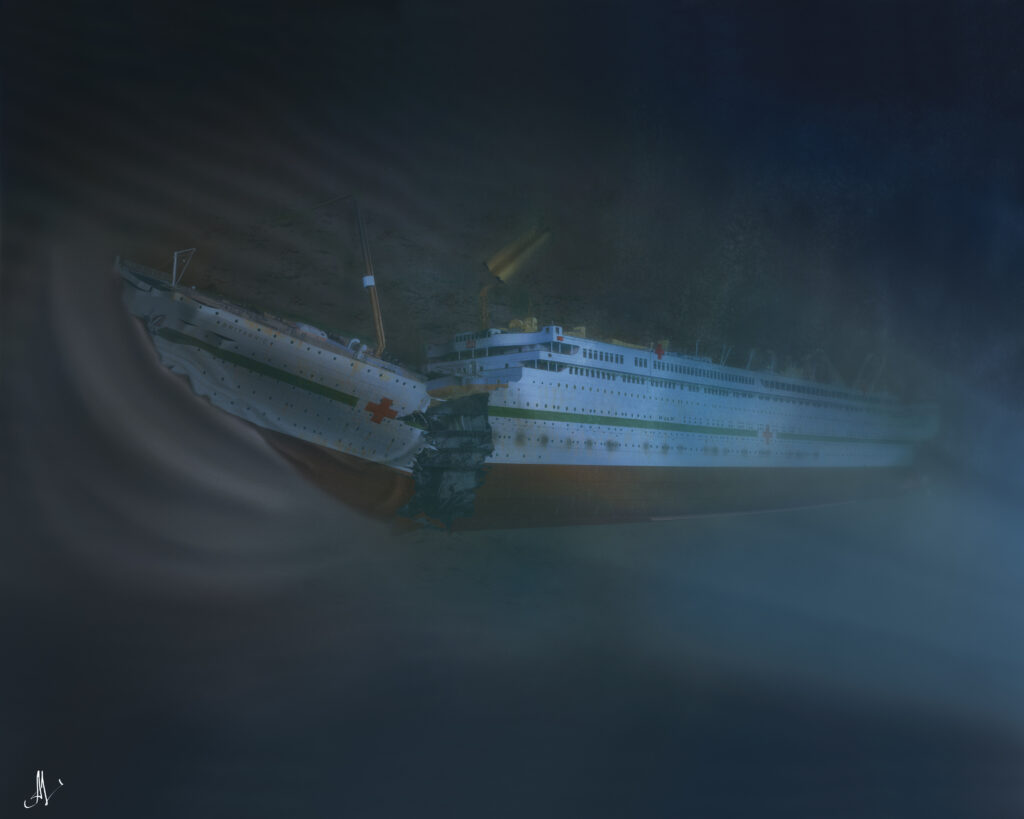
We are joined in todays stream by Rick Ayrton, a wreck diver who has been fortune to visit the wreck of Titanic’s’ sister ship, Britannic. Britannic was a hospital ship that was sunk in the first world war off the coast of Kia, without ever sailing as a passenger ship for the White Star Line. Rick Ayrton released a book on his dive to Britannic, and is available from the link below. www.divedup.com Www.titanicconnections.com
Britannic: The Palace That Never Was
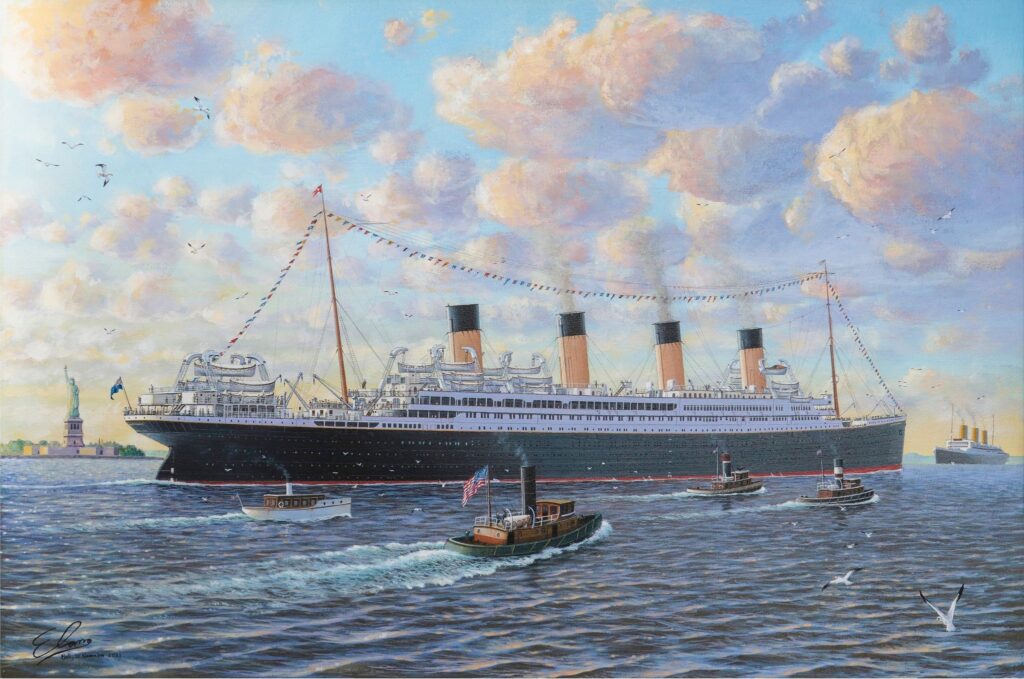
Britannic: The Palace That Never Was While Olympic and Titanic are justifiably famous for their luxuries, many people forget about the planned luxury of the third vessel in the trio, the ill-fated Britannic. RMS Britannic, had the fortunes of war not intervened, would have surpassed her earlier sisters in luxurious accommodations and appointments. The progression from the original design realized in Olympic and the final form intended for Britannic also shows the White Star Line’s continual quest to provide their passengers with the pinnacle of oceangoing luxury travel. All classes would’ve garnered improvements in the third iteration of the class. While Britannic’s large gantry davits would mark an obvious difference with the earlier ships on the outside, smaller changes would have been clear to the practiced eye. They roofed the aft well deck to provide passengers in Steerage with a covered promenade, giving all three classes such a feature. An added deckhouse on the poop also would’ve provided those travelling in third-class a more commodious smoking room above decks. First-class passengers who had journeyed on one of the earlier ships would’ve noticed a new dome over the smoking room, an additional elevator, and a children’s playroom among other additions. The real change, however, would’ve been the exquisitely crafted pipe organ rising from A-deck’s landing of the forward grand staircase. This Welte philharmonic organ, along with many other pieces that never made it aboard the liner, survives today. The organ is located in Seewen, Switzerland at the Museum Für Musikautomaten. Passengers travelling in the ship’s first class would also have been treated to something that was to become expected by the time Olympic left service in the mid-1930s. Virtually every first-class stateroom would’ve come equipped with a private bathroom. A rare feature on the first two sisters, Britannic would’ve been cutting edge in this regard and, had she survived, would’ve been far more in line with 1930s passenger expectations, raising the possibility that she might have survived longer than her eldest sister. It was, unfortunately, not to be. Britannic was never fully fitted out as a passenger liner, requisitioned for service as a hospital ship. It was in this much plainer guise that she was lost on 21 November 1916 in the Aegean Sea. We are left to examine blueprints and advertising mock-ups, as well as our own imaginations, to know what might have been for this beautiful ship.
Titanic Tours of the Wreck – The Decks
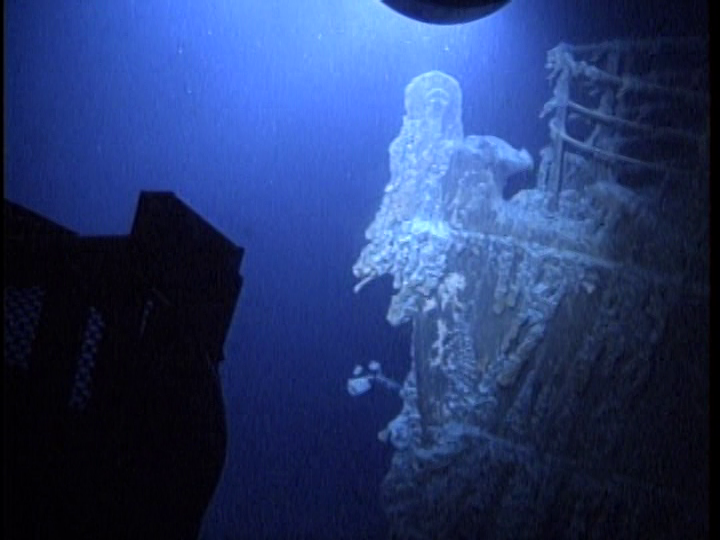
Titanic Tours of the Wreck – The Decks Yesterday Nick looked at Titanic’s decks, today we’ll look at some features of these areas on the wreck. There was a thermotank (essentially a ventilator) situated at the base of the fourth funnel as wee saw in Nick’s post. There was a thermotank also on the starboard side of this funnel and the image number 1 shows remnants of a thermotank on Titanic’s debris field. This came either from the port or the starboard side of the fourth funnel. (NOAA) Image number 2 shows this same thermotank up close from the 2010 expedition and we can see that a soup tureen lies at the base of the thermotank. (RmsTitanic,inc) In the first class smoking room, there was also a bar which had two skidlights (portholes) that provided light and air into the smokeroom bar. These skidlights were found on the raised roof structure. The smokeroom is almost completely destroyed, and these skidlights are one of the few still recognizable features of this location. We see these skidlights in the image number 3. (NOAA) Titanic’s swimming pool is unfortunately inaccessible because of closed watertight door, so we can’t explore that on the wreck. However, i looked wreck footage and i believe we see few of the swimming pool portholes on the image number 4. This is not completely certain that these belongs to swimming pool, but anyways these are F deck portholes around the area where the swimming pool was located. (NOAA) During OceanGate’s Survey expedition in 2021, they explored the debris field and came across a floor tile from first class bathroom. Similar tiles would have been found in Titanic’s swimming pool area. Image number 5 (OceanGate). Post by Sauli
Titanic Tours: Titanic’s Decks
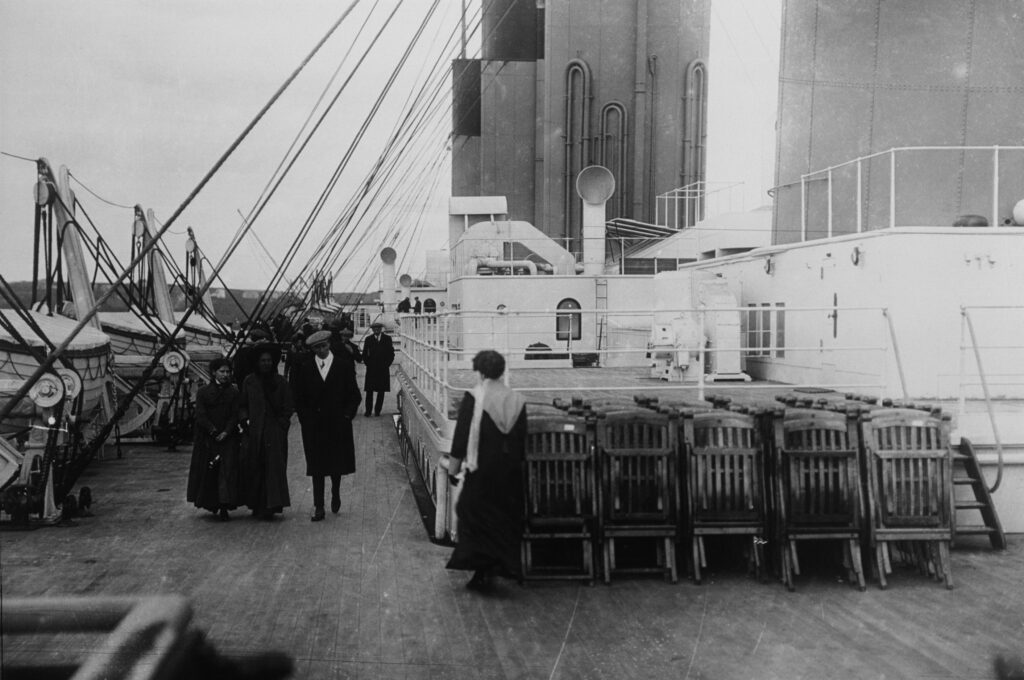
Titanic Tours: Titanic’s Decks Most Titanic enthusiasts and historians dream of the chance to walk the decks of the ship and experience her in all her glory. We imagine ourselves strolling the promenade deck or examining the boats on the boat deck. This week, we’ll explore how those decks were made. A few weeks ago, we looked at Titanic’s frames and how they formed the steel skeleton of the ship, rising vertically to form what we think of as ribs. To these frames and the beams emanating from them, the decks would be attached. It’s important to note that Titanic’s decks were not “flat” by any stretch. They would have had a gentle transverse rise in the center of about three inches. It would have been hardly noticeable to passengers unless they were paying close attention, but it was designed to ensure that water that accumulated due to wave action could easily find it’s way to the sides of the ship and then out the scuppers cut into the hull bulwarks. This rise, called “camber” was present on all of Titanic’s decks. The decks themselves were constructed of steel plates and were assembled along the same lines as the hull, with the in and out system of overlapping edges present. As discussed last week, expansion joints were incorporated into the decks above B deck to allow the rigid steel movement in a seaway. In this way, the decks could flex where needed, but otherwise they were as rigid as the hull itself, while not providing additional strength to the hull girder. The more visible and better-known element of the decks was the wooden sheathing over the steel plates. The wooden planking on her decks was not just decorative, it served a number of important purposes. As steel decks would warm in the sun or chill in the cold, the wood provided a more-uniform temperature for places where passengers and crew would walk regularly. Since wood does not transmit temperature changes, it also helped maintain the temperature inside the ship. Titanic and her sisters incorporated both pitch pine and yellow pine deck planks. The pitch pine was used in high use/high stress areas only, with the yellow pine everywhere else. Planks were typically three inches thick and five inches wide, varying in length to suit the space, and secured to the steel by heavy iron bolts. Once laid, the planks were caulked to help keep them in place. Inside the ship, wood planking was also used in some spaces, but tiles (both linoleum and ceramic), carpet, and parquet could also be found in various spaces. Ceramic tiles were often used in areas where moisture would often be present (lavatories and the swimming pool, for example),while linoleum was found in many passageways, staterooms, and public spaces. Today, tiles from Titanic’s sister Olympic are highly collectible. Next Week: Titanic’s Deckhouses Written By: Nick DeWitt Photo Credit: Titanic Connections Archive Photo Captions: 1: Passengers walk along the boat deck, where pitch pine planks can be clearly seen 2: The well-known (and now highly collectible) two-color tiles found in many parts of the ship are seen here in Olympic’s first class Smoking Room 3: Octagonal tiles are discernable here lining the deck around Olympic’s swimming pool
Titanic Tours: Titanic’s Expansion Joints
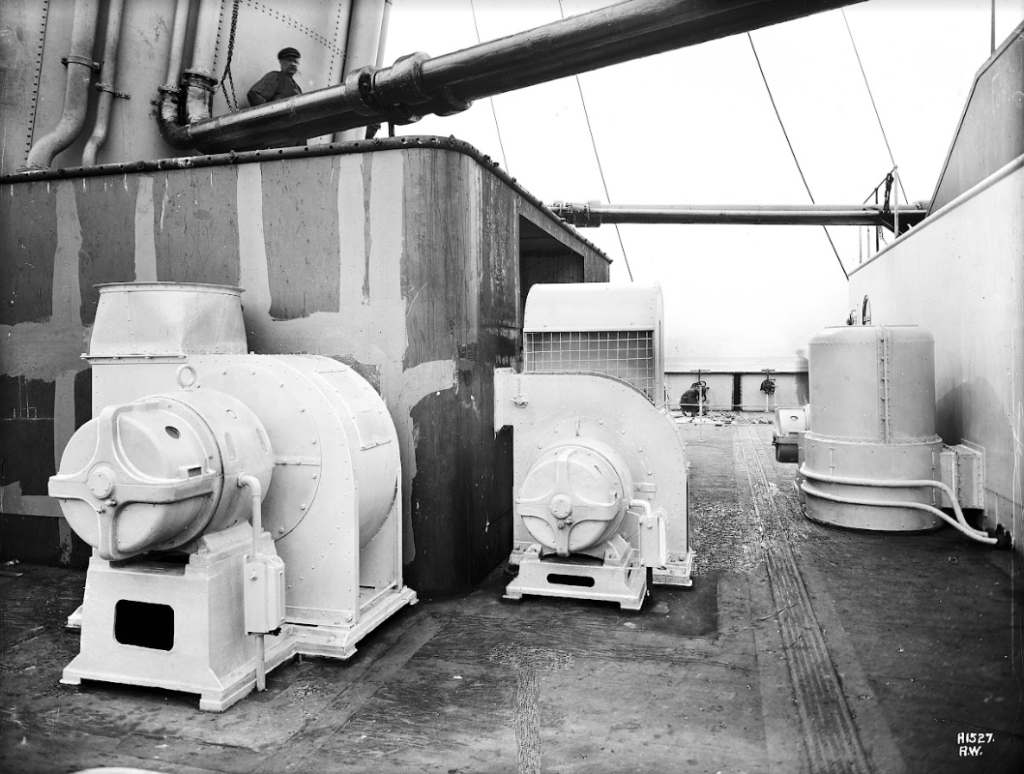
Titanic Tours: Expansion Joints In the nearly four decades since Titanic’s wreck was discovered at the bottom of the Atlantic, there has been a great deal of focus on the way the ship sank and why things happened the way that they did. A great deal of interest has arisen, naturally, around the ship’s breakup. Given the location of the break, a lot of questions have been asked about the ship’s two expansion joints and whether they could have played a role in her breaking in two as she sank. As liners grew in size, expansion joints were inserted to help the vessels survive the potentially strong seas they would face. Ships, particularly on the North Atlantic run, experienced some of the most varied and severe sea conditions in the world. Oftentimes, they would encounter series of waves that caught the hull of the ship in between. If the bow and stern were supported by water by the ship wasn’t supported amidships, she could sag there. If the opposite happened, the ship could “hog,” or bend down at the ends. Without expansion joints, the superstructure of the ships, which was built of lighter plating materials and not designed to withstand heavy stresses, would be prone to cracking or could even fail entirely. Even with expansion joints, the larger liners, including Olympic through her long career, could require servicing of these areas after encountering repeated extreme seas. Olympic and Titanic were fitted with two expansion joints, each starting just above the level of B deck and rising throughout the rest of the ship’s superstructure, allowing it to flex slightly in rough seas. The forward of these two expansion joints was located just abaft of the forward funnel at frame 49F. The after expansion joint was located between the third and fourth funnels at frame 28A. This effectively divided her superstructure, the area above B Deck, into three units. Each joint’s horizontal opening was covered with a brass plate. On the top two decks, a leather strip was also included, the leather opening and closing on the bellows principle as the joint opened or closed at sea. These leather strips were also used on the vertical openings in the superstructure. The coverings, of all types, ensured both watertight integrity, with the leather catching and draining away water it collected, and the safety of passengers. The discovery, in 2006, that Britannic’s expansion joints had a bulb-shaped base (as opposed to the was Olympic’s and Titanic’s joints met at a point), as well as the inclusion of an additional joint amidships, caused many questions to be asked about whether Harland and Wolff felt the joints were a contributing factor in Titanic’s sinking. This can be discounted by the fact that Olympic’s joints were never significantly altered during her more than two decades of service on the Atlantic and also the fact that those joints never failed or were in danger of failing during her long career, including strenuous trooping service in the Great War. The differences in Britannic, from the new shape at the base of the forward joint to the new midships joint, which shifted the after joint to the rear, and even the inclusion of a fourth joint aft where her well deck there was enclosed, can be put down to the fact that the third ship of the trio was significantly different from the first two. With Olympic having experienced some signs of stress in her first year in service (before the loss of her younger sister), it is entirely possibly that Harland and Wolff had already begun rethinking the use of expansion joints before the tragedy. In any case, the idea that Titanic’s expansion joints somehow contributed to her hull’s failure also founders on the knowledge that these joints only went as far down as B deck and were designed to allow the lighter superstructure to flex. They did not compromise the integrity of her box girder hull design, coming to an end point above the strength deck. It is important to think about what else is located in vicinity of the break, namely the large open space of the reciprocating engine room, and also to acknowledge that Titanic’s design, in modern tests, exceeded the maximum levels of stress that could reasonably be expected. As with so much else with the ship’s loss, a set of circumstances far beyond anything that could have been predicted led to a very tragic outcome. Next Week: Titanic’s Decks and Deckhouses Written By: Nick DeWitt Photo Credit: Titanic Connections Archive A view of Olympic during her fitting out. To the left, the third funnel can be glimpsed. On the right side, the lines running through the deck between the deckhouses are the ship’s after expansion joint (at frame 28A), the brass plate clearly visible in the middle of the joint. On the far bulwark, the vertical leather stripping can also be seen. The plans for Olympic and Titanic’s expansion joints, showing the various aspects of their construction and how they functioned. Previous Next
Design D: The Interior
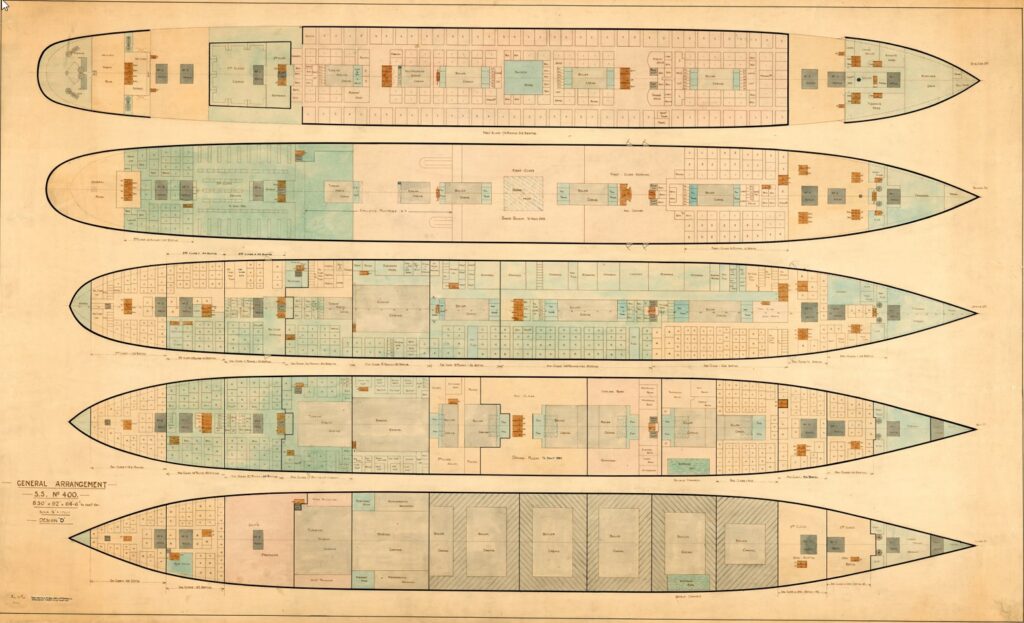
Titanic Design D: The Interior Did You Know… …that the interior arrangements in the original design for the Olympic-class ships, known as Design D, are just as varied from what was actually built as the external features we discussed in last week’s post? While the lack of a second mast after and a clustering of the ship’s lifeboats along the after boat deck is certainly a visual departure from the Olympic-class liners we’ve come to know and love, passengers stepping aboard would have found the ships to be very different from the ones that eventually set sail in 1911 and 1912. The most noticeable change would be the grand staircases. In both cases, these would have been more typical and rectangular staircases, similar to what we eventually saw in the Olympic-class’ second class spaces. The elevators, or lifts, would not have been located behind the forward grant staircase, but across from the front of the staircases, with a port and starboard elevator rather than a stand of three lifts. A deck would be very similar in layout to what was eventually built, with the Lounge, Smoking Room, Palm Court, and Reading and Writing Room all located in the same spots and with the same general shape. The aft part of the deck would have been smaller without the protrusion for the mast and also seems to be lacking the large cargo cranes, although it’s unclear if these are just omitted in the drawings, as no cranes appear around any hatches. B deck is very similar in design to the Olympic, with a large promenade space along the sides, but two major differences jump out from the drawing. The first is the lack of an A La Carte Restaurant for first class passengers. Instead, the second class smoking room is much enlarged. The more interesting change, however, comes near amidships, where there is a large space noted to be for a dome over the first class Dining Saloon. Olympic and her sisters would have a single-deck space for first class to dine, a radical departure from the grand, multi-deck spaces on other large liners built in England, Germany, and France. Design D, at least in this respect, places the Olympic-class ships closer to their contemporaries. This space is also marked on the plans for C deck. In both cases, this unbuilt dome would have taken up space later used for cabins and other small rooms. C deck is otherwise a near-mirror for the as-built ships, with only minor changes to the number and shape of rooms. D deck, however, is radically changed. The first class entrance and a second lounge space, what was later termed the reception room, is much larger in the original plans. Ironically, the final reception room was considered to be a bit too small. The major change here is that the entrances are not walled off from the staircase landing, providing a more open space without altering the rest of the floor plan. Interestingly, the otherwise typical staircase fans out on D deck into a shape more recognizable to our eyes. It is interesting to ponder what Design D’s Dining Saloon would have looked like with a two-deck dome space in its center. The third class General Room is housed here near the stern, as opposed to opposite the Smoking Room for that class on C deck in the final design. E deck holds little more than a few minor alterations, but F deck provides yet another surprise. The Gymnasium, to eventually be found on the starboard side of the Boat Deck, is on the starboard side here instead. The Turkish Bath area is shifted to the port side, where spaces for stewards were eventually located. While this seems a jarring change to us now, this may have been a more practical one in 1912. Olympic and Titanic did not have spaces for changing attached to their Gymnasium. Passengers using the facility would’ve had to pass through public spaces to change, something that would’ve been odd for the times. Most ships that housed a gymnasium at the time had it in the same location as found in Design D. G Deck holds our final major surprises, with the omission of a Squash Court forward being among two notable changes. The other is the location of the ship’s Post Office. Unlike in the final design, where the Post Office was forward on G Deck, Design D places it on the starboard side, but far aft in an area eventually occupied by third class berths. This would certainly have changed some of the story on the night of 14 April 1912, when the mail clerks were among the first to report that their area of the ship was flooding fast. Design D, like most initial designs for any structure, shows a lot of similarities with the what was finally built several years later, but it also shows some interesting differences, some that would’ve advanced beyond typical designs of the time and some which would’ve been a step backward from what eventually became Olympic and Titanic. It is fascinating to look at these designs today and imagine just how different these ships could’ve been. Written By: Nick DeWitt Photo Credit: Titanic Connections Archive Previous Next
Wreck Thursday: An Overview of Titanic’s Stern
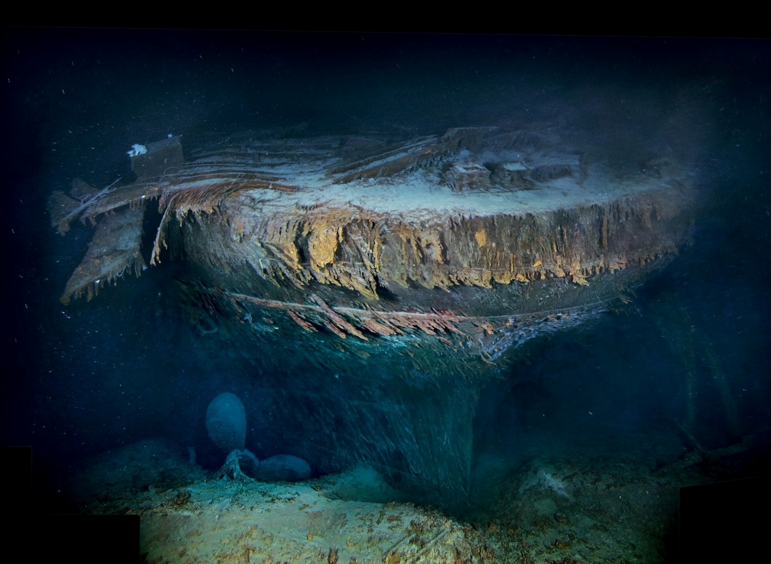
Titanic’s Stern Section: An Overview Located 1,970 feet (590m approx) due South of the Titanic’s bow, lay the mangled remains of the Titanic’s stern section. This area of the ship, the last part of the great vessel to vanish beneath the North Atlantic surface, was a honeycomb of compartments that included crew spaces, 2nd & 3rd class quarters, cargo storage, engineering areas, refrigeration, kitchens, as well as having several large areas for the ventilation of her engineering spaces as well. It is for this exact reason (its design) that the stern section lies so mangled on the seafloor today… These great open areas, many of them containing air pockets, were dramatically, and catastrophically blasted apart by pressure as the great liners sank to the ocean’s depths. The stern section has been covered occasionally in previous Wreck Thursday posts, but it is my hope to ‘Return’ to the Stern in the next series of posts and see if we can’t pick out any details that have otherwise gone unnoticed… Lets begin this ‘Return’ with an overview of the entire Stern Section… Post by: Matthew Smathers Information & Images Courtesy Of:Encyclopedia Titanica,Daniel Klistorner,NOAA,Vasilije Ristovic,Father Browne Collection,Roy Mengot,Titanic: The Ship Magnificent,Bruce Beveridge,Ken Marschall,Mark Draper,Cyril Codus,Woods Hole Oceanographic Institute,Rms Titanic Inc.Storied Treasures Collection,
Titanic Tours: Making Titanic Watertight
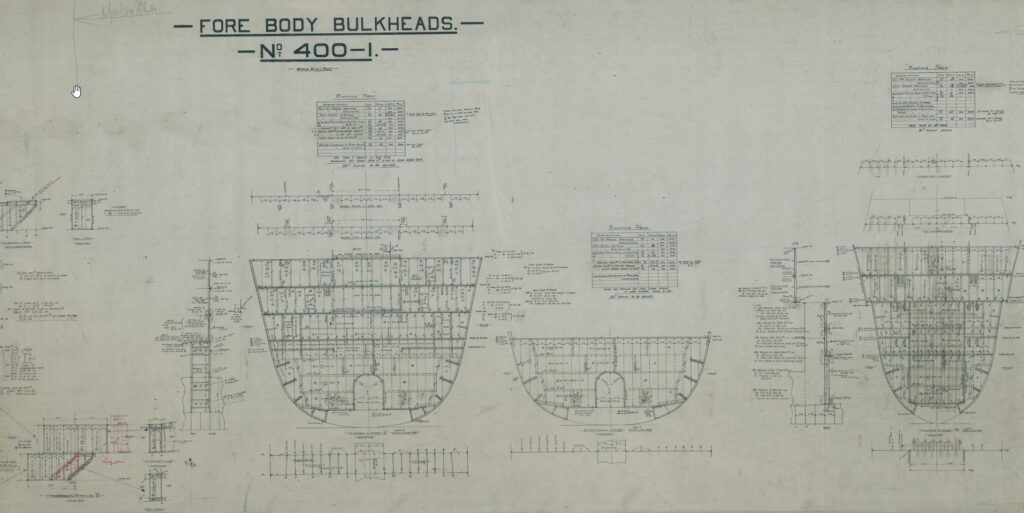
Titanic Tours: Making Titanic Watertight One of the much-ballyhooed features of the Olympic-class liners was their safety features. It would be these safety features, including her watertight doors and subdivision, that would cause the trade publication Shipbuilder, in their 1911 special number, to declare Olympic and Titanic “practically unsinkable.” Surviving a collision at sea was seldom a guarantee, but ships built before Titanic, in some cases many years before, had survived collisions with other ships and even with icebergs. Sinkings, however, were not uncommon in such incidents, with the RMS Republic in 1907 and the RMS Empress of Ireland in 1914 showing that collision damage much less widespread than on Titanic could cause a vessel to founder. Still, despite the accident to Titanic on her maiden voyage, and the later loss of her sister Britannic during World War I, the Olympic-class ships were designed and built with a high degree of safety features. Chief among these features was the cellular double bottom we’ve already discussed in Part 1 of this series. The double bottom formed an inner skin along the vulnerable bottom of the ship. If one of these ships ran over a submerged wreck or rock, it may puncture the outer skin, but would potentially leave the inner skin unscathed, allowing very minimal flooding to occur and permitting the ship to continue with her voyage. Titanic also had watertight bulkheads that divided the lower decks of the ship. Fifteen transverse bulkheads, running from one side to the other, created sixteen watertight compartments. The largest of these would be the space reserved for the ship’s enormous reciprocating engines. Others were of varying sizes, with the bulkheads also not proceeding in a straight vertical line. These bulkheads were lettered from the bow beginning with A and ending with P, omitting the letter I. Each bulkhead rose from the top of the double bottom (known as the Tank Top) as high as either the Upper Deck (E Deck) or the Saloon Deck (D Deck) and remained watertight to that height. The decks themselves were, for the most part, not watertight, lending to the more modern descriptions of the ship’s subdivision as similar to that of an ice cube tray. These bulkheads, pierced by watertight doors that we shall examine in a moment, gave the liners a high degree of survivability in a collision. One of the worst mishaps that could occur at sea was a collision with another vessel that opened two adjoining compartments to the sea. The Olympic-class ships could survive such a scenario. They could also survive an accident that damaged any three of the first five compartments or even the first four compartments from the bow. Unfortunately for Titanic, her damage just exceeded these possibilities, dooming her. A side-swipe collision opening five or six compartments was not a common or likely scenario, so it was believed that these new ships could survive virtually any mishap that would befall them. Most of these bulkheads (excluding E, F, G, H, and J) had watertight access doors built into their structure. When closed, the bulkhead was watertight. At the level of the Tank Top (the floor of the boiler rooms, coal bunkers, and engine spaces), these doors were of the vertical-sliding variety we are familiar with from films and photographs. These doors were more narrow aft of the boiler rooms, the wider doors in the boiler rooms allowing for the transportation of coal from the bunkers in wheelbarrows. The doors were each held open using an electronic clutch that could be released locally or remotely. If released, the doors would drop quickly into the closed position and thus seal the bulkhead. Each door also was equipped with a float system that would automatically close the door if water rose to 1 ½ to two feet above the tank top. Once closed, the only escape from that compartment would be up vertical escape ladders. These variously led to E Deck, where Scotland Road was located, or up to the Boat Deck. Above the boiler and engine spaces on E Deck and D Deck, the bulkheads were pierced by horizontal-sliding watertight doors. These had a similar look and construction, but operated on a rack and pinion system that would press the door firmly against the bulkhead once closed. These doors could be closed locally from either the same deck or from the deck above using hand cranks. Finally, the liners were equipped with several watertight doors on hinges, which operated the same as a standard door, with a rubber gasket around the rim. These could be sealed by pulling the door shut and turning several “dogs” to firmly seal the gasket to the frame. After the sinking, several design changes were made to both the building Britannic and, during her next overhaul, the Olympic. These would expand the two ships’ double skin from the bottom up the sides, extend some of the watertight bulkheads to B Deck, and provide a panel on the ship’s bridge that showed the status of the watertight doors. This panel is erroneously depicted as being aboard Titanic in most films, but it was not a part of her design. Other smaller changes would also be made, and together these would allow the Olympic and Britannic to survive a Titanic-style accident. Each vessel would now be able to float with her first six compartments opened to the sea. Unfortunately, despite these design changes, Britannic would succumb to a mine in 1916 while serving as a hospital ship. Next Week: Titanic’s Expansion Joints Written By: Nick DeWitt Previous Next A look at the bulkhead design from a bow-on perspective, showing the overall shape of the bulkheads and the ways in which various doors pierced them at each deck. Photo: Titanic Connections Archive Previous Next The starboard elevation plan used at the British Titanic Enquiry in the summer of 1912, showing each watertight bulkhead labeled below the hull. Photo: Titanic
Did You Know… All About Titanic’s Design “D”
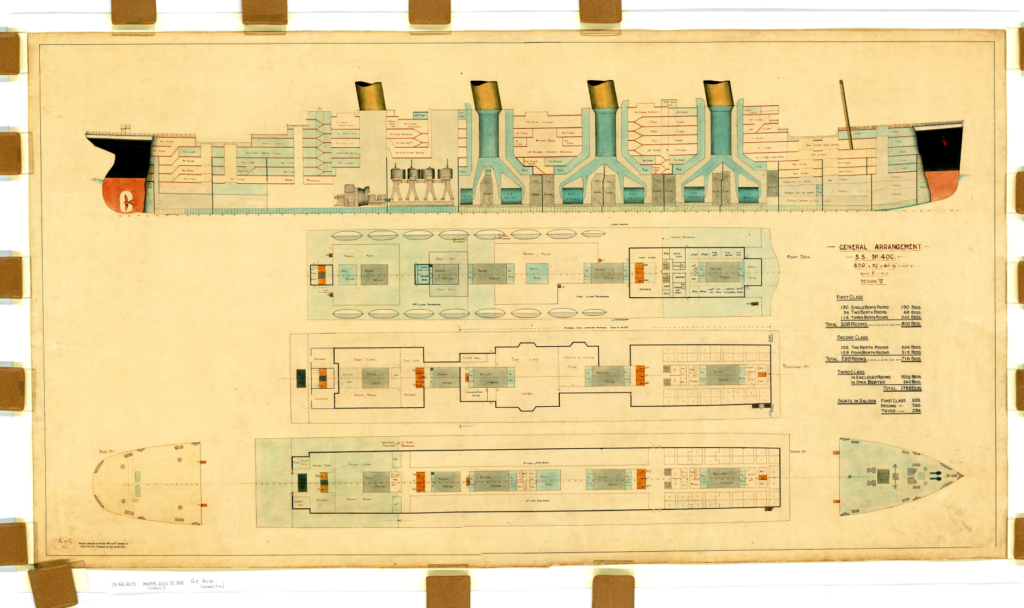
The Intended Exterior of Design “D” For the Olympic Class Did You Know… …that the original design accepted for the Olympic and Titanic, known as “Design D,” had a number of major differences from the two ships that were eventually launched in Belfast? While there are no known drawings of what presumably would be called Designs A, B, and C, we do have the existing Design D drawings, which are the ones upon which Harland and Wolff would have presented to the White Star Line when the two agreed upon the building of the two ships (with the possibility of a third to be completed later). The presumption has always been that the three “missing” designs would be scaled-up versions of the Big Four liners, particularly Adriatic, the last of that grouping. We can only wonder at what the first conceptions of White Star’s new mammoths might have been. Design D, however, shows not so much a scaled-up Adriatic but a design that is in some ways a radical departure from that of ships of the time and in others very reminiscent of other contemporaneous designs. Perhaps that most noticeable thing about Design D, given how important they would later be to Titanic, are the ship’s lifeboats. The design shows 14 full-size lifeboats with two smaller cutters at the front. This, at least, matches the initial compliment on Olympic and Titanic save for the additional four Engelhardt collapsible boats. All 16 boats, however, are placed aft on the boat deck, with the cutters being just abaft the second funnel and each followed by seven evenly-spaced regulation lifeboats. This would have drastically changed the appearance of the new ships. While the placement of the lifeboats would’ve been different to our eyes, it would’ve followed the practices seen in the Big Four. Adriatic’s boats were situated after just as Design D shows them for the Olympic-class ships. A more radical change in the design, however, would be the omission of a mainmast. While not necessarily the first thing noticed in the drawings, a closer inspection shows only the foremast. This would have completely altered several aspects of the Olympic-class ships and been a complete departure from contemporary designs of the time. The new Lusitania and Mauretania each had two masts, while the Big Four ships each had four. A single mast would not become vogue until near the end of the ocean liner era in the 1950s and 1960s. Beyond the visual changes, the Olympic-class ships would have had to make alternative arrangements for their wireless aerial, which could no longer be suspended between two masts. It is likely that, as with some later vessels such as the Empress of Britain in the 1930s, that this aerial could have been suspended between two of the funnels. As wireless was still in its infancy in 1907 and 1908 when these designs were coming together, this was likely not a primary concern to Harland and Wolff, but if followed through on, it could’ve had an important impact on the Titanic during her ill-fated maiden voyage. The rest of the outward design, as far as we can tell, is likely to be very similar to what we have come to know. Four buff, black-topped funnels, the graceful counter stern, the classic bow shape, and even the overall shape of the superstructure are all there very close to the way we remember them. There’s no complete exterior drawing to show exactly what she would’ve looked like, but it’s safe to say that she would’ve looked similar on the outside. The one other exception is the center anchor and hawse pipe, which do not make an appearance on either the overhead drawing of the forecastle or the starboard elevation. The compass platform might also have been located elsewhere, as a dome over the first class lounge appears to be in that spot in Design D. Internally, however, the ships would be quite different. Next time, we’ll take a look at the internal differences between Design D and the Olympic-class as they were built. The first page of the original drawings for Design D, showing a starboard elevation and overhead looks at the Boat Deck, A Deck, and B Deck (including the forecastle and poop) Previous Next

